Feed aggregator
The Unseelie King - Book Review by Voodoo Bride
 The Unseelie King (Maze of Shadows #4)by Kathryn Ann Kingsley
The Unseelie King (Maze of Shadows #4)by Kathryn Ann KingsleyWhat is it about:One king is dead, and the other is in chains.
Tir n’Aill perches on the edge of a knife in the wake of a series of betrayals that has shaken the fae to the core.
Abigail finds herself questioning who is friend and who is foe. When she is forced to make her decision between mercy and love, she finds her choice is one that might tear the very world apart.
Forces gather to wage war and decide the fate of Tir n’Aill. And in the center of it all, Abigail is nearly torn in two, caught between her desire to protect her new people and her love for Valroy.
For he is now the Unseelie King. The world is his to burn.
And only she can stop him.
What did Voodoo Bride think of it:*more spoilers ahead*So I gave this book a 5 star rating on Goodreads, and I stand by it, but this book destroyed me.
I know I talked mainly about Abigail and Valroy in my other reviews, but there were other really cool characters as well. Especially Anfar, the best (and probably only) friend of Valroy.
In this book things get dark, gruesome, but it seemed there could be a solution that would lead to a satisfying ending. And to be fair: there is a kind of bittersweet Happily Ever After if you don't overthink it. But the costs to Valroy and Anfar: too high in my opinion. I cried so hard over the ending. That'll teach me to fall in love with a dark creature from the Unseelie Court and his 'creature from the depth of the ocean' best friend.
All in all this is a great series, but I might be too soft for it, and too invested in friendship over the main romance.
Why should you read it:It's a really good if you can handle the dark stuff in it.
Comment on Worldbuilding Articles: 2025 Reader Poll Results by Kevin
In our defense I thought Byron implied that knowledge about the Winged was known in the Drucraft world, I believe he mentioned the Mountains and the Cathedrals to Lucella and there seems to be mythological figures mentioned like Ogun and Perun that seem to be gangs/criminals/pseudo Cults. So just general information that isn’t too spoilery since they are so powerful and influential some information must be known to the average drucrater without going to overboard, kinda of how the average person knows Special Forces exists but not know how and where they function.
But aside from that looking forward to learning about the Corporations Essentia capacity Branch affinities and the rest!
(I will miss learning about the Drucraft branch affinities with their cultural associations plus what planets the rest are associated with, I want to know how far out we get possibly to Uranus or Neptune or if the Moon and Earth count for ones.)
The Fiction of Edgar Rice Burroughs, Part IV: The Hollow Earth and Pellucidar
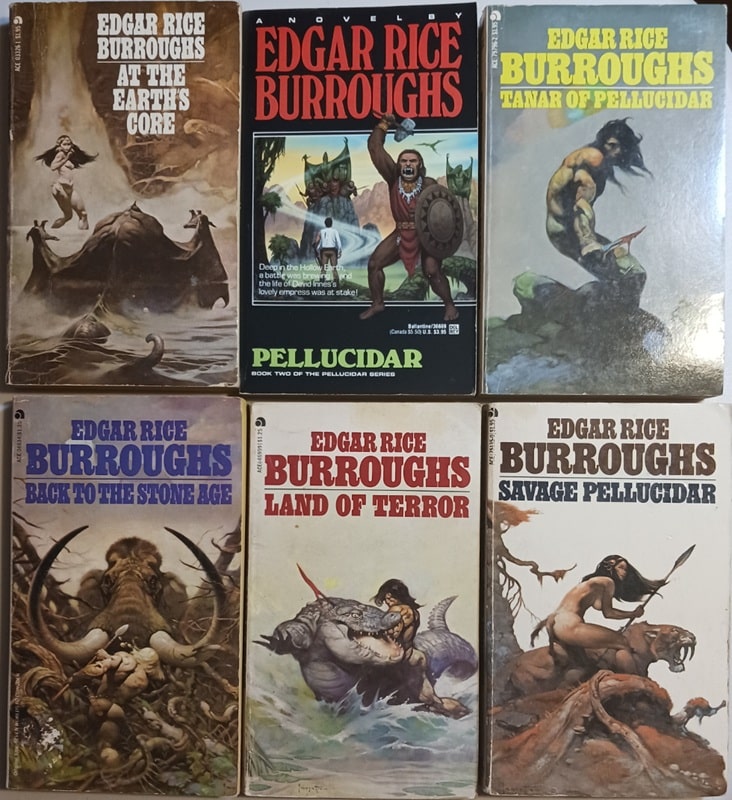 The Hollow Earth novels of Edgar Rice Burroughs: At the Earth’s Core (Ace Books, August 1978), Pellucidar (Del Rey, May 1990), Tanar of Pellucidar, Back to the Stone Age, Land of Terror, and Savage Pellucidar (Ace Books, January 1973). Covers by Frank Frazetta and David Mattingly (Pellucidar)
The Hollow Earth novels of Edgar Rice Burroughs: At the Earth’s Core (Ace Books, August 1978), Pellucidar (Del Rey, May 1990), Tanar of Pellucidar, Back to the Stone Age, Land of Terror, and Savage Pellucidar (Ace Books, January 1973). Covers by Frank Frazetta and David Mattingly (Pellucidar)
Above are my Edgar Rice Burroughs Pellucidar books. Tarzan at the Earth’s Core goes with this series as well, although I included it in Part II of this series, with my Tarzan collection. In these stories, Pellucidar is a hollow area at the center of the Earth. There are openings into it at the North and South poles, but in the initial book, At the Earth’s Core, an American named David Innes reaches the interior by riding inside a giant drill. This is kind of a reverse of the Sword & Planet plot in which the Earthman is taken outward to another world.
Pellucidar is an interesting construction and ERB clearly gave it some thought. There’s a miniature sun at the center that leads to perpetual day, and the only shadowy area on the surface of Pellucidar is an area of constant twilight beneath the bulk of the unmoving moon. The interior has no horizon because everything curves up and away from the viewer, and the land and water masses are the reverse of the surface, leaving a lot of land. The world is populated by all kinds of extinct outer lifeforms that wandered in through the polar entrances, including some dinosaurs and the remnants of the mammal megafauna.
It also contains humans, and some weird races that never existed on the surface, including the Mahars, who are winged reptilian-like beings possibly evolved from Pterodactyl-like ancestors. The Mahars rule the interior world and David Innes leads a revolt against them that is fought out during the first few books. In Tarzan at the Earth’s Core, Tarzan takes an airship into the interior world and gets involved in the war. Some of the later books are made up of stories that were originally published separately.
There are 7 Pellucidar books, listed below with first publication dates. My copies are all later releases, of course, and all from Ace Books, except for Book 2, From Del Rey. I’ve also listed the publication dates and cover artists here for my copies.
At the Earth’s Core, 1914: 1978, Frazetta
Pellucidar, 1915: 1990, David B. Mattingly
Tanar of Pellucidar, 1929: 1978, Frazetta
Tarzan at the Earth’s Core, 1929-1930 (not shown above)
Back to the Stone Age, 1936-1937: Frazetta cover (My Favorite)
Land of Terror, 1944: 1973, Frazetta
Savage Pellucidar, 1963: 1978, Frazetta
I like the Pellucidar series a lot, and it was the single biggest influence on Lin Carter’s Zanthadon, which I wrote about in a Facebook post quite a while back.
 Lin Carter’s Zanthodon novels: Journey to the Underground World, Eric of Zanthodon, Hurok of the Stone Age, Darya of the Bronze Age, and Zanthodon (DAW Books, November 1979, May 1982, February 1981, September 1981, and June 1980). Covers by Josh Kirby and Thomas Kidd (Zanthodon)
Lin Carter’s Zanthodon novels: Journey to the Underground World, Eric of Zanthodon, Hurok of the Stone Age, Darya of the Bronze Age, and Zanthodon (DAW Books, November 1979, May 1982, February 1981, September 1981, and June 1980). Covers by Josh Kirby and Thomas Kidd (Zanthodon)
The idea of a Hollow Earth that Burroughs used in his Pellucidar books, or at least of great caverns beneath the earth, is very old. Quite a few Native American tribes have origin stories that include them coming from out of hollows in the earth. Edmond Halley proposed it as a serious theory in 1692, and, of course, there’s Jules Verne’s Journey to the Center of the Earth, published in 1864.
A couple of years ago, my wife and I visited Mammoth Cave in Kentucky and saw evidence of Native Americans having visited and perhaps lived there. I also found out about a book with the lengthy title Wonderful Discovery: Being an account of a recent exploration of the celebrated Mammoth Cave, in Edmonson County, Kentucky, by Dr. Rowan, Professor Simmons and others, of Louisville, to its termination in an inhabited region, in the interior of the Earth.” I managed to find a copy online.
 Wonderful Discovery by Montgomery E. Letcher (Forgotten Books, August 24, 2018)
Wonderful Discovery by Montgomery E. Letcher (Forgotten Books, August 24, 2018)
Written in 1839, this story purports to be a journey into the Hollow Earth through the Mammoth Cave system. It’s only a long opening chapter, and supposedly there were to be further installments. This is the only one I’m aware of. This piece has the intrepid explorers getting through the cave system into the inner world where they meet a peaceful group of humans. There’s not much excitement; no “narrative drive,” like you get from ERB.
I was unable to find anything on the author Montgomery E. Letcher. My search suggests this is the only work he ever did. The writing is, naturally, very old fashioned, and the concept was apparently derived from Halley’s suggestion of the Hollow Earth. The story precedes Jules Verne’s Journey to the Center of the Earth by decades, since that book was published in 1864. It seems likely to me, however, that Verne arrived at the idea directly from Halley’s writings rather than from having read this work. And I doubt Burroughs knew about it either.
 Map of Pellucidar from An Atlas of Fantasy by Jeremiah Benjamin Post (Ballantine Books, January 1, 1979)
Map of Pellucidar from An Atlas of Fantasy by Jeremiah Benjamin Post (Ballantine Books, January 1, 1979)
Above is a map of Pellucidar, from An Atlas of Fantasy. The same basic map is featured in some of the books as well. ERB drew it himself.
ERB and Some PastichesGetting back to ERB’s Pellucidar, there’s also a sequel to the series written by John Eric Holmes (1930 – 2010) called Mahars of Pellucidar. It follows the events of Savage Pellucidar. My copy appears to be from the first printing, from ACE, 1976, with a great cover by Boris. I actually enjoyed this tale quite a bit. It was authorized by ERB’s heirs, although they originally nixed a sequel Holmes wrote called Red Axe of Pellucidar. This was eventually published, with the consent of ERB, Inc, although I don’t have it and haven’t read it.
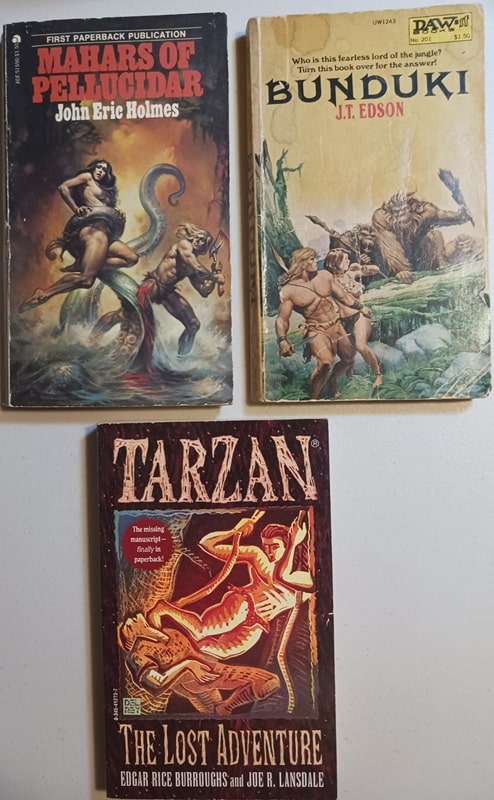 Mahars of Pellucidar by John Eric Holmes (Ace, 1976), Bunduki by J.T. Edson (DAW, April 1975), and Tarzan: The Lost Adventure, by Edgar Rice Burroughs and Joe R. Lansdale (Del Rey, June 1997). Covers by Boris Vallejo, Michael Whelan, and Raymond Verdaguer
Mahars of Pellucidar by John Eric Holmes (Ace, 1976), Bunduki by J.T. Edson (DAW, April 1975), and Tarzan: The Lost Adventure, by Edgar Rice Burroughs and Joe R. Lansdale (Del Rey, June 1997). Covers by Boris Vallejo, Michael Whelan, and Raymond Verdaguer
The other books I have shown above with Mahars is Joe Lansdale’s (1951-) fleshed out Tarzan novel Tarzan: The Lost Adventure, which he wrote from a long outline found in ERB’s effects after his death. It’s not quite a pastiche. Nor is it my favorite book from Lansdale, who has written many truly wonderful works. This is from Del Rey, first published in 1995. The cover is by Raymond Verdaguer. I’m sure this is perfectly competent work of art but it didn’t do much for me, and I don’t understand why they didn’t use one of the artists who did the great interior sketches, such as Gary Gianni or Michael Kaluta.
The last pastiche shown here is Bunduki, by J. T. Edson (1928 – 2014), cover by Michael Whelan. It features Tarzan’s adopted son and adopted granddaughter (Bunduki and Dawn). It throws us right into a mystery. Bunduki wakes up in a tree in a tropical jungle, but it isn’t Africa. He’s amazed since he was in a Land Rover that ran over a cliff and should have been dead. Dawn was with him but is missing. It turns out that the two have been mysteriously transported to another world, which turns out to be a counter-earth (opposite our Earth) called Zillikian. This makes it essentially a Sword & Planet novel, although pretty light on the sword part.
Edson wrote three approved novels of Bunduki and a fourth one and some short stories that were not approved by the ERB heirs. I’ve only read the first one but the complete series is:
1. Bunduki, 1975
2. Bunduki and Dawn, 1976
3. Sacrifice for the Quagga God, 1976
4. Fearless Master of the Jungle, 1980
Edson had written a partial fifth novel called Amazons of Zillikian, which was published in 2023. I’ve never seen it. Edson, a British author, was best known for his westerns, particularly a very long series about the Floating Outfit, which ran to 66 books. I’ve read one of those, which was rather intriguing since it involved Cowboys and Aliens.
I might have picked up the other Bunduki books but they are exceedingly expensive in paperback. They are cheap for the Kindle but I’ve got way too many books on Kindle already.
Previous installments in this series include:
The Fiction of Edgar Rice Burroughs, Part I: Sword and Planet
The Fiction of Edgar Rice Burroughs, Part II: Tarzan and The Land That Time Forgot
The Fiction of Edgar Rice Burroughs, Part III: The Westerns and The Mucker
Charles Gramlich administers The Swords & Planet League group on Facebook, where this post first appeared. His last article for Black Gate was The Fiction of Edgar Rice Burroughs, Part III: The Westerns and The Mucker.
Book Review: Greenteeth by Molly O’Neill
I received a review copy from the publisher. This does not affect the contents of my review and all opinions are my own.
Mogsy’s Rating: 4 of 5 stars
Genre: Fantasy
Series: Stand Alone
Publisher: Orbit (February 25, 2025)
Length: 320 pages
Author Information: Website
Here I go again, writing a review for another historical fantasy novel inspired by fairy tales and folklore. That said, every so often, a book will emerge that puts a fresh spin on an old story or bases its premise on lesser-known mythological creatures. I, for one, had never heard of Jenny Greenteeth, or Wicked Jenny, before picking up Greenteeth by Molly O’Neill. A kind of bogeyman-type water monster from English folklore, her name was used to warn careless children away from the treacherous shores of lakes and rivers, lest Jenny pulls them in and drowns them. Huh. It’s always great to learn something new.
Obviously, the novel Greenteeth centers on this terrifying figure, who is typically depicted as an evil hag ready to snatch her unsuspecting young victims and drag them into the murky depths. O’Neill, however, prompts readers to look at Jenny in a whole new light. She’s a monster, all right. But monsters can have feelings too, and they can sometimes be the hero instead of the villain. Living in her secluded lake, Jenny can get lonely. And whenever a human wanders close to her abode, she just can’t help her curiosity.
One day, her inquisitive nature leads to a decision that changes everything. Accused of witchcraft, a woman named Temperance from a nearby village is thrown into the lake by an angry mob led by their fanatical new preacher. Against her better judgment, Jenny chooses to save her, sheltering Temperance and letting her recover in her lair. Soon, the two of them find themselves in an alliance against an emerging foe that threatens both Jenny’s lake and Temperance’s family. Bound by magic, the two of them seek help from Brackus, a traveling goblin trader who deals in magical reagents and information. The trio next sets out on a quest to save their home, a journey that takes them across the lush British landscape and even to the very heart of the faerie realm.
There’s a lot to love about Greenteeth. The world-building is particularly robust, immersing readers in its rich atmosphere as well as the myths that inspired the characters and setting. The author doesn’t skimp on the details; you’ll notice how elements from all kinds of sources make their way into the novel, including Arthurian legends, Old English literature, Celtic mythology, and real history. Her prose is also very well suited to the vibes she wants to convey—a world that feels both grounded and magical, neither fantasy nor reality but straddling that in-between space, giving it all a dream-like quality.
And yet, this approach also has the downside of making the plot feel overly simplistic, almost like a children’s tale. This became especially true when Jenny, Temperance, and Brackus were tasked to do a bunch of what were essentially fetch quests, a narrative structure that’s both formulaic and predictable. At times, even the characters’ personalities felt underdeveloped, reduced to broad emotional strokes that, unfortunately, ended up defining them. One of the story’s most significant conflicts, for example, stemmed from little more than Jenny throwing a massive temper tantrum. While it’s an incredibly effective way to humanize our monstrous protagonist, I confess to being somewhat disappointed that, under all those sharp edges which made Jenny so mysterious and intriguing, all we got was a petulant child.
Still, for a debut novel, Greenteeth is an impressive achievement and an excellent entry into its genre category. Molly O’Neill’s love of fantasy and folklore is clear from her descriptive prose, as is her affection for the legendary figure of Jenny Greenteeth, whom she writes about with care and compassion. Sure, there were a few things that could have used more polish, but despite these flaws, Greenteeth showcases a promising new voice in fantasy. While it might not be anything groundbreaking, I found it to be a very worthwhile and enjoyable read.
![]()
![]()
Goth Chick News: Getting Our Heavy Metal Back…
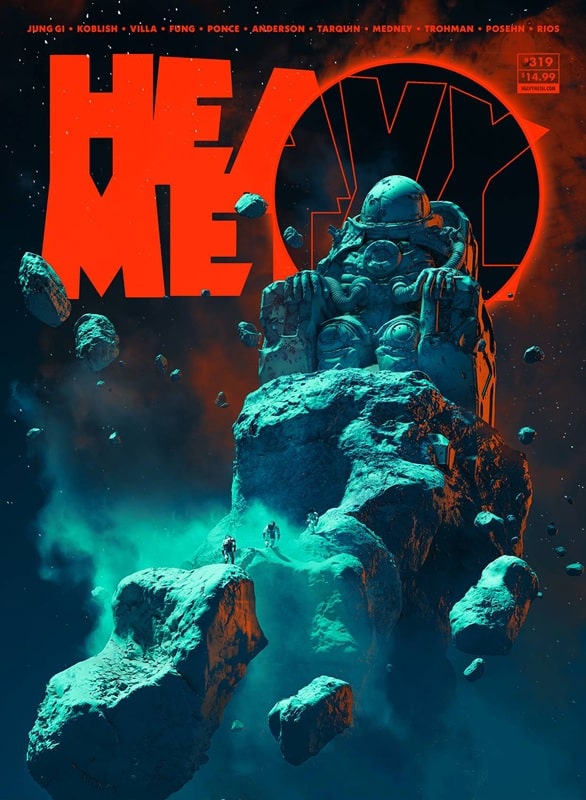 Heavy Metal #319, the penultimate issue of the original run (November 2022). Cover by Pascal Blanche
Heavy Metal #319, the penultimate issue of the original run (November 2022). Cover by Pascal Blanche
Okay, strictly speaking, this topic doesn’t fall into a standard (notice I didn’t say “normal”) Goth Chick category. But bear with me for a short story.
A long time ago in a small midwestern town far, far away, I experienced my first hardcore crush. The subject in question was not only tantalizingly a few years older than me but he was decidedly gothy in a dark-warrior kind of way. Therefore, in my youthful opinion, he was perfection on two feet. That same year as I was sitting cross-legged on the floor of my local bookstore my eyes fell on an issue of Heavy Metal magazine where low and behold was my crush, or someone who looked darn close, personified in all his brooding magicalness, right there on the cover. That day my allowance went to my first issue of Heavy Metal and though I was a rabid fan for years afterward, I admittedly became hit and miss, buying only sporadic issues throughout the 2000’s.
Heavy Metal magazine, which had been in constant publication since 1977, printed its last issue in 2022 after a series of attempts to keep it viable, and an era came to an end.
Until now.
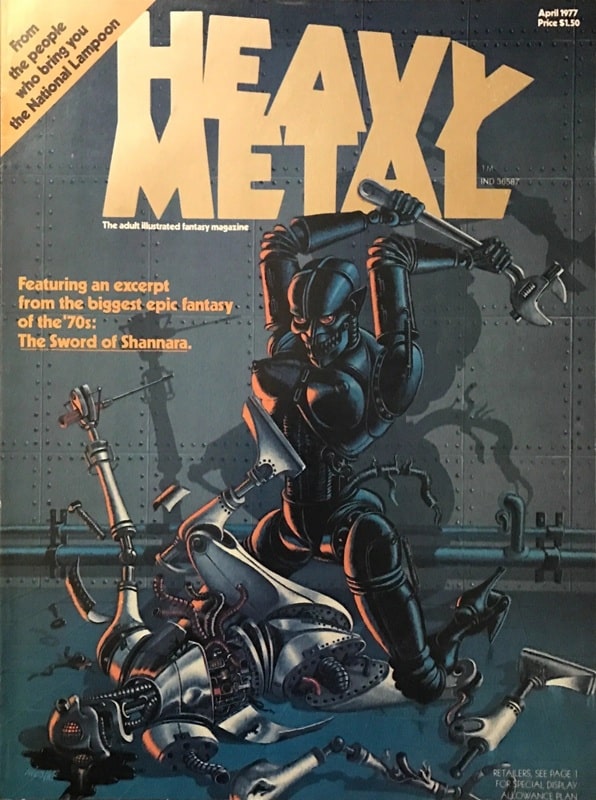 Heavy Metal issue #1, April 1977. Cover by Jean-Michel Nicollet
Heavy Metal issue #1, April 1977. Cover by Jean-Michel Nicollet
Before we get to that, let’s back up for some history.
Heavy Metal debuted in April 1977, bringing avant-garde European comic art and adult-oriented storytelling to American readers. Inspired by the French magazine Métal Hurlant (“Screaming Metal”), Heavy Metal was launched by Leonard Mogel, who licensed the rights to translate and publish content from its French counterpart. The magazine quickly distinguished itself with its blend of science fiction, fantasy, horror, and erotica, rendered in fantastic artwork and experimental narratives.
In its heyday, the contributors to Heavy Metal included legendary artists like Moebius, H.R. Giger, and Philippe Druillet, alongside American talents such as Richard Corben. Heavy Metal became the go-to publication for visionary creators, showcasing serialized stories, one-shot comics, and memorable (and boy were they memorable) covers that pushed boundaries all over the place.
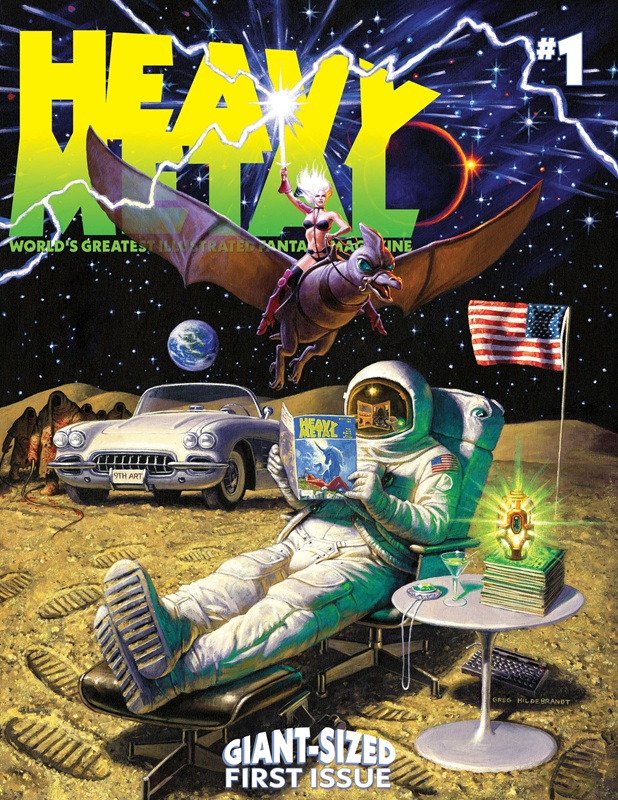 Heavy Metal #1 (April 30, 2025). Cover by Greg Hildebrandt
Heavy Metal #1 (April 30, 2025). Cover by Greg Hildebrandt
The magazine reached a broader audience with the release of the cult animated film Heavy Metal (1981), an anthology of shorts inspired by its comics and featuring a soundtrack of iconic rock and metal bands. This cemented its reputation as a cultural touchstone for fans of both countercultural comics and rock music.
Over the years, Heavy Metal evolved under various editors and owners, including Kevin Eastman, co-creator of Teenage Mutant Ninja Turtles. In January 2014, its ownership transitioned to digital and music veteran David Boxenbaum and film producer Jeff Krelitz. Eastman, though stepping back from majority control, remained as publisher until 2020 and retained a minority stake in the magazine under Heavy Metal Media, LLC.
In early 2020 CEO Matthew Medney and “Creative Overlord” David Erwin (formerly of DC Entertainment) took the helm. They launched new publishing initiatives, Virus and Magma Comix, though neither gained much traction. In 2021, Heavy Metal celebrated its 300th issue, featuring work by legendary artists and tributes to its cultural impact.
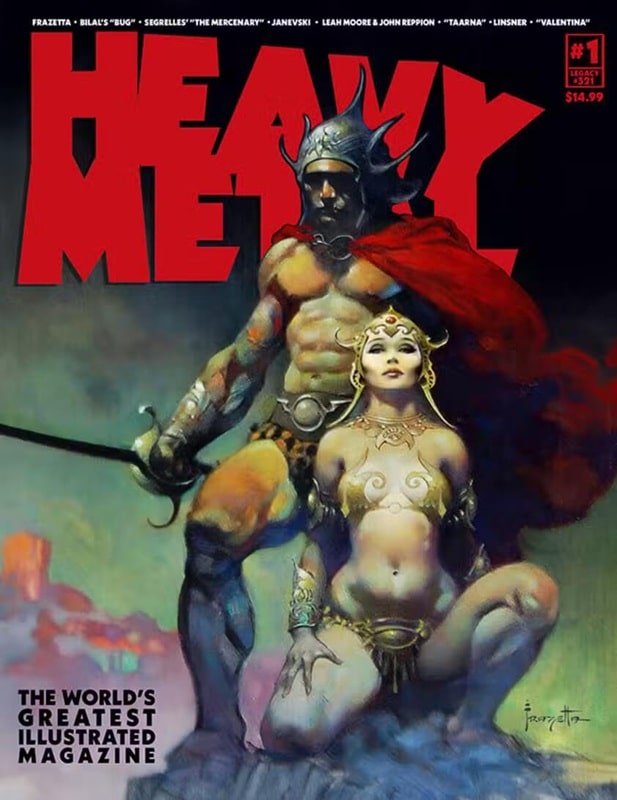 Heavy Metal #1, Sword & Sorcery variant (April 30, 2025). Cover by Frazetta.
Heavy Metal #1, Sword & Sorcery variant (April 30, 2025). Cover by Frazetta.
Financial struggles loomed, leading to a partnership with Whatnot Publishing in 2022 to produce future issues. However, cash flow problems forced Heavy Metal to cease publication in December 2022, ending its continuous run since 1977. Despite efforts to revive operations and fulfill obligations, only one additional issue was produced, and the magazine was officially canceled in mid-2023.
Which brings us to today.
In October 2024, Heavy Metal International, LLC announced a relaunch planned for 2025, backed by a Kickstarter campaign to fund it. The campaign had a modest $5000 goal but nearly 11,000 fans proceeded to blow that right out of the water and contributed a whopping $781K. HMI put together this short video announcing the comeback of the magazine so check it.
Heavy Metal magazine (new) issue 1 is set to drop in April in stores, and the magazine’s website indicates that subscriptions to the new version will be available there soon. I’m definitely going to give this a look when it hits shelves to see if Heavy Metal was a point in time, or if it can be successful in this era.
Thoughts?
Comment on Worldbuilding Articles: Reader Poll (2025 Edition) by Skeeve
1. Essentia Capacity
2. The Board
3. Sigil Recycling
4. Attunement
Galadon- Chapter 1
Spotlight on “The Paris Express” by Emma Donoghue
The Paris Express, a sweeping historical novel about an infamous 1895 disaster at the Paris…
The post Spotlight on “The Paris Express” by Emma Donoghue appeared first on LitStack.
On McPig's Wishlist - Hemlock & Silver
I totally need this!
 Hemlock & Silverby T. Kingfisher
Hemlock & Silverby T. KingfisherFrom New York Times bestselling and Hugo Award-winning author T. Kingfisher comes Hemlock & Silver, a dark reimagining of “Snow White” steeped in poison, intrigue, and treason of the most magical kind.
Healer Anja knows little of politics but much of poisons. When she is summoned to treat the mysterious illness afflicting the king’s daughter, she finds herself against the clock, desperate to track down the source of the poison killing Princess Snow. But the chance discovery of a strange alternate world inside a magic mirror leads Anja to darker discoveries, including what really happened to Snow’s dead sister, Rose, and why their mother seemingly went mad and cut out her heart.
Aided by a taciturn bodyguard, a narcissistic cat, and a late Renaissance understanding of the scientific method, Anja must navigate the mysteries of the mirror world before the dark queen that dwells within rises to threaten them all.
Expected publication August 19, 2025
Comment on Worldbuilding Articles: Reader Poll (2025 Edition) by Yishan
In reply to Bill.
1. Corporations
2. Board
3. Sigh Recycling
Book review: Witchcraft for Wayward Girls by Grady Hendrix

Book links: Amazon, Goodreads
ABOUT THE AUTHOR: Grady Hendrix is the author of the novels Horrorstör, about a haunted IKEA, and My Best Friend's Exorcism, which is like Beaches meets The Exorcist, only it's set in the Eighties. He's also the author of We Sold Our Souls, The Southern Book Club's Guide to Slaying Vampires, and the Final Girl Support Group!
He's also the jerk behind the Stoker award-winning Paperbacks from Hell, a history of the 70's and 80's horror paperback boom, which contains more information about Nazi leprechauns, killer babies, and evil cats than you probably need.
And he's the screenwriter behind Mohawk, which is probably the only horror movie about the War of 1812 and Satanic Panic.
You can listen to free, amazing, and did I mention free podcasts of his fiction on Pseudopod. He also does a podcast called Super Scary Haunted Homeschool.
If you're not already sick of him, you can learn all his secrets at his website.
Publisher: Berkley (January 14, 2025) Length: 468 Formats: audiobook, ebook, hardcover, paperback
Grady Hendrix strikes again, this time with Witchcraft for Wayward Girls. He’s trading haunted houses for something much scarier - societal judgment, systemic abuse, and the 1970s institution of unwed mothers’ homes.
The story follows 15-year-old Neva Craven, a pregnant teen dragged by her irate father to Wellwood House, a grim institution in Florida where “wayward girls” forced to give up their babies. Renamed Fern, Neva bonds with her fellow captives - budding revolutionary Rose, sharp Zinnia, and sweet Holly. These girls have been abandoned, dismissed, and exploited by the very people who should protect them.
While there are witchy parts and mischief, the real horror here lies in the everyday atrocities - the crushing weight of societal judgment, toxic families, and the grim realities of childbirth. Fair warning: if you’re squeamish about body horror, this one might hit hard. The story here hits hard, and it’s only Hendrix’s humor and warmth that keep things from sinking into despair.
As mentioned, things take a turn for the magical when a cryptic librarian offers Fern an intriguing book, titled How to Be a Groovy Witch. Things get complicated and sinister when girls play with spells and have their revenge. It’s worth noting the revenge they seek is hard won and comes at a cost, but oh, is it satisfying to see the power dynamics shift, even briefly. The magic and witchcraft parts were most interesting to me and I’ll admit the ending was a bit of a disappointment, but I can’t say why because spoilers.
Despite the heavy themes-shame, injustice, and society’s knack for blaming teenage girls for pretty much everything-Hendrix balances it all with a light touch. If you like your horror with heart, Witchcraft for Wayward Girls is worth picking up. It’s a little spooky, a little sad, and satisfying.
Following in the Steps of Robert E. Howard: The Eye of Sounnu by Schuyler Hernstrom
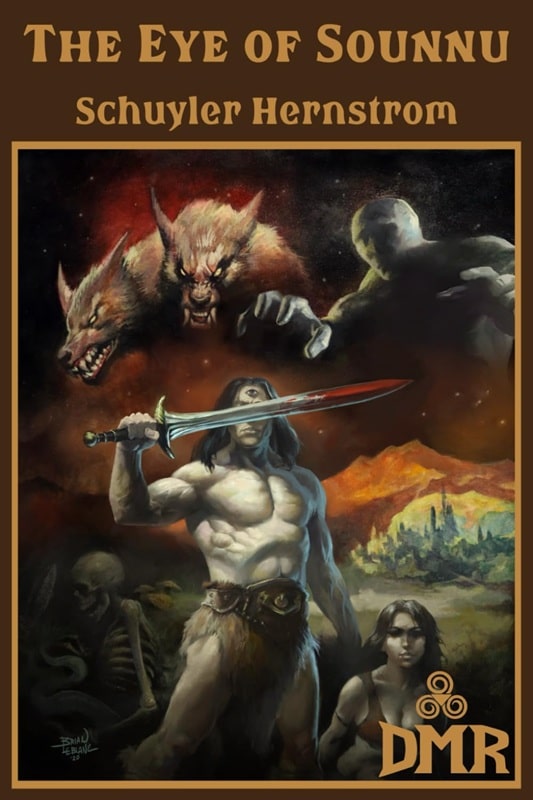
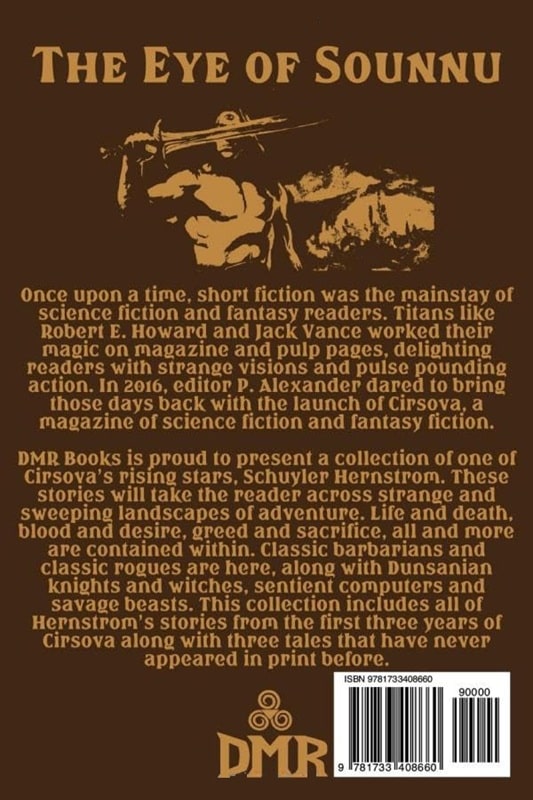
The Eye of Sounnu (DMR Books, May 3, 2020)
The concept of barbarism vs. civilization is a topic that Robert E. Howard often explored in his incredibly crafted fiction. Other authors, many inspired by Howard, have explored the concept through their own creations.
Notable among these is modern sword-and-sorcery author Schuyler Hernstrom, whose collection of short stories, The Eye of Sounnu, was published by DMR Books. The collection contains a wonderful story called “Mortu and Kyrus in the White City,” which features northland, pagan barbarian (Mortu) and his learned companion (Kryus), a monotheistic monk who suffers a curse and now lives in the body of a monkey — but that does not preclude him from waxing philosophically about the world and mankind’s place in it.
There was an exchange between the two that I recently read, and I had to reread it, and then reread it again, because I enjoyed it so much, so I share it here, for my friends of similar interests.
(This takes place shortly after the two arrived in “the White City.”)
Mortu whispered to his friend. “How old do you reckon she is?”
Kyrus shrugged. “Perhaps thirty-five, forty? Forty-five at the oldest.”
“Everyone here, the men and the women, all seem to be the same age save Nathia and the (two) children. Where are the families? Where are the elderly?”
“In mankind’s long history, many people have struck off in order to found their idea of a utopia. I suspect the denizens of the White City are such a group. All those that turn away from society in such a way meet a similar fate, gradual disillusionment and dissolution.”
“Utopia?”
Kyrus’ tone became pedantic. “A perfect society.”
Mortu scoffed. “There is such a place, the north, where my people live as the gods intended.”
“My young friend, once again the essential concepts escape your grasp, like eels slipping from your thick fingers. While you may wrongly believe the savages that raised you to be of a perfect society, I refer to man’s long dream of living without inequality or strife.”
The barbarian scoffed again. “Life is conflict. We are but wolves that walk on two legs. Build your temples, write your books, nothing will ever change.”
Lastly, I’d like to thank my friend Morgan for recommending this excellent collection a few years ago. I am enjoying it immensely.
Order copies directly from DMR’s website.
Jeffrey P. Talanian’s last article for Black Gate was Roy Thomas’ Barbarian Life. He is the creator and publisher of the Hyperborea sword-and-sorcery and weird science-fantasy RPG from North Wind Adventures. He was the co-author, with E. Gary Gygax, of the Castle Zagyg releases, including several Yggsburgh city supplements, Castle Zagyg: The East Mark Gazetteer, and Castle Zagyg: The Upper Works. Read Gabe Gybing’s interview with Jeffrey here, and follow his latest projects on Facebook and at www.hyperborea.tv.
Kindle USB, The Price of Books, and Other Things

It is freezing here in Texas. We had a 40 degree temperature drop, and now we are sitting at 24 degrees. You know my prayer. Hold, grid, hold.
The Price of Printed BooksIs it true that the price of printed books will rise?
Yes. Most of the books are printed in China or on paper imported from China. When the new tariffs go into effect, the prices will increase. It is very difficult to shift that production chain. The publishers tried during the pandemic and we had delays across the board. The Ingram Spark, print-in-demand publisher used by a lot of self-published authors, already announced the anticipated price hikes.
How much more will they cost?
We don’t know. Could be a couple of bucks, could be more. There is no way to tell yet. Nobody is happy about this situation, but that is the way it is. The cost of tariffs is passed onto the consumer, and we have to make at least $1 off each printed self-published book, or we cannot afford to continue.
A reminder: the political ban is still in effect.
Kindle USBLet me say upfront, before there is a panic: this will not affect most people, because most of us do not bother with it. If you are wondering if this will affect you, then you probably haven’t used this feature before.
Most people either read their Amazon books on Kindle or on Kindle app. I use the Kindle app primarily, because I tend to read on my iPad or search the books for work on my computer. My books sit in my cloud library until I’m ready to download them to my device.
Some people back up their books to a USB device, meaning they download those files to a storage drive or a USB stick. A loose equivalent would be buying a movie on Amazon and burning it onto a DVD to keep.
Amazon is doing away with that ability. It goes away on February 25th.
Let me reiterate: most of the users will not be affected. You can still email the book files to your kindle, you can still download the books to your kindle, and they will still be available in app. If you haven’t downloaded books to store them somewhere else before, you will not notice.
Why is Amazon doing this?
Although we buy books on Amazon, our actual ownership is more similar to renting. We buy access to that book for as long as Amazon has it available. Amazon wants to make sure you continue to give it your money. If you delete your Amazon account, all of your books will disappear with it.
We have seen this model before with Audible, which is now owned by Amazon. When you buy audiobooks on Audible, you accumulate credits and if you cancel your account, you lose access to all of your purchases and credits. It’s an effective way to keep consumers tied to you. (Please see correction on this in the comments. Apparently, deleting the Audible account doesn’t prevent access.)
It does afford some flexibility. Amazon periodically pushes updates to these books. We have updated our books before because of typos or some inadvertently poor word choice or something the readers pointed out. If a publisher pulls out and takes their titles with them, Amazon wants to be able to disappear them from your library so not to be in breach of contract, etc. But mostly it’s about money and keeping you locked into the Amazon ecosystem.
Downloading these books to a storage device safeguards against that. If this is a concern, you have until February 25th to download your titles.
How?
Here is a video explaining how to do it. We have no idea if the software he recommends for bulk downloads is good, so we do not endorse it. Please do your research: Amazon’s New Kindle Rule.
Thank you to Jennifer Thomas from the Facebook Fan Group for bringing it to our attention.
Please do not email to Mod R asking her how to download your books to the storage device. The gentleman explains it in the video. We love you, but we cannot serve as Amazon tech support. We are not qualified.
Maggie UpdatesThe final content edit pass for Maggie’s book has landed. So much work has gone into this monster of a manuscript, and if it was printed, I would be lifting it above my head the way Moses in the movies lifts the stone tablets.
It means we are close to the manuscript being accepted for publication. It also means Gordon and I have a ton of work ahead of us to try to clean the story up. This is kind of our last chance to make large edits.
It is very exciting. We had a title conference and a cover conference, and now we are waiting to see what the art department is going to come up with. It is almost a book. Woo!
The post Kindle USB, The Price of Books, and Other Things first appeared on ILONA ANDREWS.
7 Author Shoutouts | Authors We Love To Recommend
Here are 7 Author Shoutouts for this week. Find your favorite author or discover an…
The post 7 Author Shoutouts | Authors We Love To Recommend appeared first on LitStack.
The Unseelie Throne - Book Review by Voodoo Bride
 The Unseelie Throne (Maze of Shadows #3)by Kathryn Ann Kingsley
The Unseelie Throne (Maze of Shadows #3)by Kathryn Ann KingsleyWhat is it about:When the prize is death, some games are better lost than won.If she loses, she becomes his queen, and he unleashes war across Earth and Tir n’Aill alike. If she wins, he dies. The answer seems clear. But then why can’t she bring herself to want victory?
The longer Abigail wanders through his Maze of Shadows, the less sure she becomes of anything—allies, enemies, wrong, right, evil, good, hate…and love. With every twist and turn, her heart is more fully trapped in his snare.
Facing the choice of whether to win—and kill the Bloody Prince—or lose and become his queen, Abigail can’t decide which is worse. In fact, she is starting to think that she might no longer want to win at all.
No matter the cost.
What did Voodoo Bride think of it:*spoiler ahead*The second book felt a bit like filler, even though I enjoyed it very much. This book is back on track, and there's lots of good scenes between Abigail and Valroy.
I was so invested in this story and the likely doomed romance between them. They might be attracted to each other, but are on opposite sides. Can you be both lovers and enemies?
Then there's finally the first 'all the way' scene and I was... disappointed. It was more about how looooong Valroy is (Peter Steele would have liked a word, were he still alive) than it being satisfying after all the tension and waiting.
Luckily later scenes had the steam and enjoyment I really needed after all the bad things that happened to Abigail since the start of this series.
And then the ending!
I immediately needed the last book to see if this series could end happily or if I would get my heart broken.
Why should you read it:It's a really addictive if sometimes brutal Dark Fantasy (Romance?)
Comment on Worldbuilding Articles: Reader Poll (2025 Edition) by DR
1. Corporations
2. Branch affinities
3. Essentia capacity
New Treasures and Interview: C.S.E. Cooney’s Saint Death’s Herald
Black Gate’s interview series on “Beauty in Weird Fiction” queries authors/artists about their muses and methods to make ‘repulsive things’ become ‘attractive.’ We’ve hosted C.S. Friedman, Carol Berg, Darrell Schweitzer, Anna Smith Spark, and Janet E Morris (full list of 29 interviews, with Black Gate hosting since 2018).
This round features C. S. E. Cooney (CSEC), who is no stranger to Black Gate [link to listings]. She is a two-time World Fantasy Award-winning author: first, for Bone Swans: Stories, and most recently for Saint Death’s Daughter. Previously on Black Gate, an all-star crew heralded its release with a video cast including readings of Saint Death’s Daughter by C.S.E. Cooney.
Forthcoming in April 2025 is Saint Death’s Herald, the second in the Saint Death series. In this post, we reveal exclusive details, CSEC’s creative process, and hint of Book #3’s contents! Read this and her contagious energy will infect you! Cripes, simply by doing this interview, I was infected with a buttery aura! Read more and learn C.S.E. Cooney’s real identity and code name too (Tiger of the gods? Or is it Lainey!)
An Interview with Saint Death’s Daughter (a.k.a. C.S.E. Cooney)SEL: Saint Death’s Daughter was released in 2022, and we’ll dig into that momentarily. Mark Rigney interviewed you a decade ago Black Gate (2014 link). How have you changed as an author since then? Were you inspired by your Lord Dunsany readings?
Re-reading that 2014 interview is hilarious. And exuberant. And painful. Oof. That line towards the end about Howard making me read Lord Dunsany? Seth, I have to say that right now, I just want Howard alive again, and making me read anything at all. That’s what I want.
[SEL Sidebar: Howard Andrew Jones, Black Gate print magazine editor, longtime author, and friend/mentor to countless writers, passed away this January after battling aggressive brain cancer. CSEC led the charge with a GoFundMe campaign for his family (with help from a crew including the just-mentioned Mark Rigney), and Black Gate has hosted several tributes (i.e., from John O’Neill, Jason Ray Carney, & Bob Byrne); as one of HAJ’s Skull Interns, I am capturing links to many more memorials. Peace to our dear friend.]
Otherwise, sadly: I don’t recall much about my Lord Dunsany readings. I didn’t even remember that reading Dunsany made me want to be referred to as “the tiger of the gods.” Now, why didn’t that catch on, I wonder? You may henceforth refer to me in this interview as “tiger of the gods,” please.
Have I changed as an author since then? Yes. Yes, I’m not as fast as I was ten years ago, and everything about the world seems harder, and sadder. I think it was always hard and sad, but I’m feeling it more now, I guess.
But also… also, it’s all so much more interesting.
Over the last ten years, I’d experienced such burnout, such weariness and bitterness about the craft, that at one point I announced I wasn’t going to write again until I wanted to write. My friends and family were afraid I was serious. (I was.) They were like, “Claire, what are you doing?”
But I really just wanted to want to write. Was any of the work even worth it if I didn’t want it anymore?
And it took a few weeks of me staring out a window, giving myself permission not to write. But then, suddenly and spontaneously one morning, I had one of those magical “what if” thoughts. That was something that hadn’t happened in literally years of revision and submission and revision and submission. The next morning, that “what if” had built into a whole dang story idea. So I sat down and started writing it out long hand — something I’d also not done in years. The experience was so pleasurable, so permissive, and so, I don’t know. Healing.
The whole world seemed new. Writing was possible again. Phew! I’d made it through the wasteland and to the other side.
Since then, the whole creative process just keeps getting weirder and more wonderful. Concentrating on the unique bizarreness of process has really opened me up to so many branching avenues of boundless curiosity.
Now I know: if I need to stop writing for a while, I will. (After I meet my deadlines, of course. That’s what a professional does.)
For me, the sensual ritual of writing has become the point. And community. Community is the point.
What else has changed? I’ve never done so much body mirroring while writing in my life: writing in silent zooms, or with people in the room. I’ve never done so much timed writing. I even started listening to music while writing — which I never used to do. I still can’t listen to anything with words (some Hildegard von Bingen chanting aside). I started listening to fantasy gaming soundtracks, because if I listen to movie soundtracks, I just have that movie’s story and dialogue running through my brain. But since I’ve not played most fantasy games, that’s not a problem. (I can’t, for example, listen to the Baldur’s Gate soundtrack, because I did play that. Which was awesome.)
I know this now: even when I’m sad, and tired, and lacking all motivation, I still want to want to write. All the rest is hacking my brain to get the motor running. Music, company, handwriting, candlelight… all of those rituals put me in a more celebratory and ludic headspace for writing.
What’s the same? Well… every time I have to write something new, it’s still like learning how to write all over again. Some of the same skills apply, sure, but I’m constantly learning how to write something I couldn’t even fathom before I started.
Like fight scenes. Fight scenes are so hard.
“Henceforth refer to me in this interview as ‘Tiger of the Gods’ ” — C.S.E. Cooney Saint Death’s Daughter (2023 World Fantasy Winner) Blurb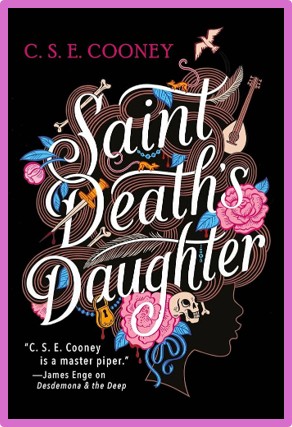
Nothing complicates life like Death.
Lanie Stones, the daughter of the Royal Assassin and Chief Executioner of Liriat, has never led a normal life. Born with a gift for necromancy and a literal allergy to violence, she was raised in isolation in the family’s crumbling mansion by her oldest friend, the ancient revenant Goody Graves.
When her parents are murdered, it falls on Lanie and her cheerfully psychotic sister Nita to settle their extensive debts or lose their ancestral home — and Goody with it. Appeals to Liriat’s ruler to protect them fall on indifferent ears… until she, too, is murdered, throwing the nation’s future into doubt.
Hunted by Liriat’s enemies, hounded by her family’s creditors and terrorised by the ghost of her great-grandfather, Lanie will need more than luck to get through the next few months — but when the goddess of Death is on your side, anything is possible.
At first glance, the summary of Saint Death’s Daughter sounds like a horror adventure, but it reads more like a comedic/fun, coming-of-age story. How would you describe the book to new readers?TIGER OF THE GODS: Generally, I give this elevator pitch: “Girl grows up in a family of assassins, but is allergic to violence. Her allergy indicates that one day, if she survives long enough, her aversion to violence will be so strong, she’ll be able to RAISE THE DEAD.”
Boom! Necromancy book, baby.
For comp titles, I say something along these lines: “Like if Terry Pratchett and the Addams Family had a necromancer baby who really liked pink frilly dresses and cutie patootie mouse skeletons.”
Those are light, easy ways about talking about my book. My book which is, in reality… much weirder.
BUT! I really don’t want to intimidate people. I want to invite people.
I also like to describe Saint Death’s Daughter as a Bildungsroman — a coming-of-age story. Now, I know that all YA books must perforce be coming-of-age stories. That’s the genre. It’s just that, at no point in the drafting process, did I imagine I was writing YA with Saint Death’s Daughter. But it is still a Bildungsroman.
I am, as I was ten years ago, still under the influence of Lois McMaster Bujold. I wanted to write a character like Bujold’s Miles Vorkosigan. The first few novellas about him may have covered his childhood, but over time, we get to experience him at many ages.
Saint Death’s Daughter is just Lanie Stones’s first book. It’s just one point in the timeline of her full life — perhaps not even the most important part. I imagine her in her thirties. (Sexy beast!) Her forties! (Whoa, what a powerhouse!) I imagine her as an old woman — with even more wisdom and compassion and mischief, and far, far more powerful. (Also, probably a foodie.) I imagine her on her deathbed. I imagine future scholars writing about her as a historical figure of a certain time and place that is perhaps no more. (This makes footnotes very fun.)
SEL: Discuss the media of necromancy which feels very artistic, especially the paint-like, colored essences of panthuama and ectenica.TIGER OF THE GODS: I made up the word “panthauma” out of the words “pan” (all) and “thaumaturgy” (miracle or marvel-working). I wanted a word for sorcery that was slightly alien, so I could apply my own set of rules to it without previous reader bias. But I also wanted, in addition to that whiff of mysterious, a sense of familiarity, linguistically-speaking.
And then I wanted a new word for “death magic” that wasn’t just, you know “death magic.” “Necromancy” is the obvious word, and I do use it in the book. But its actual etymology has more to do with divining via the dead than raising them up. (All the “-mancy” words have to do with divination.) So I wanted necromancy to be a specific kind of death magic, not the word for death magic.
I wanted a new word, something more flexible, less familiar. A word that evoked ghosts! And also super fun to say. So I took a closer look at our word “ectoplasm,” and then just sort of f*&%ed with it to make “ectenica.” Just say it aloud. All those clicky consonants!
Lanie’s a bit of a synesthete, in that she associates smells and colors with magic; that’s her brain trying to process the unimaginable. So, for panthauma, when the gods are drawing close and lighting up the world with Their attention, her vision goes bright-yellow with hard edges, like faceted topaz, and her body responds with a kind of champagne-y, effervescent reaction. Her sensual reaction to ectenica is much colder. She perceived it as a sort of starry blue. And the smell of her god, and of death magic, is always some variation of citrus. Other gods have other smells. I think, to some degree, most of the sorcerers/saints in my world have synesthesia.
SEL: Celerity Stones, one of Lanie’s aunts, was also a traditional artist, and her portfolio included portraiture like “Barely There: The Exquisite Art of Excoriation, With (Predominantly) Live Models”. I’d love to see her collection. Can you tell us more about Celerity’s inspiration and art?Celerity had been much in demand for her pen and ink drawings, her sanguine sketches, her oils, watercolors, and illuminated calligraphy. Later, she won renown as an anatomical scientist. Very precise with spreader, was never easy to ignore her most famous work, The Flayed Ideal, which hung on the wall of Stones Gallery and had a way of glaring at you. Its exposed and accusatory eyeballs, rendered in oil on canvas with exquisite delicacy, followed you around the room — and very often out the door and down the hall.
— from Saint Death’s Daughter
TIGER OF THE GODS: You know those stories we have of anatomists and resurrection men in prior centuries who’d illegally dig up bodies in order to study them, to become better doctors? (I’m glad that the laws — and some minds — have changed to allow for voluntary donation in such endeavors, but for a while it was considered absolutely heinous.) And you know all those stories about how powerful people in history — doctors, surgeons, psychologists, prisons, military — exploited marginalized communities, sometimes going so far as to medically experiment on people without their informed consent, for purposes of their own research?
That’s my inspiration for Celerity Stones.
She was not a good person. She was talented and precise and obsessed with her work. But she — like the whole toxic Stones family — hurt people to achieve her greatness.
One of the reasons that the Stones family ultimately falls is that cruelty like that is not sustainable, however it sometimes seems to advance society in the moment. Undoing the Stones’s legacy, and especially the glamorization of the violent family narrative, is something that Lanie has to consciously learn how to do as she gets older.
SEL: Every time I’ve seen you at Gen Con, you are wearing impressive regalia. Do you craft the costumes? Do they represent characters?TIGER OF THE GODS: I don’t craft costumes, per se. Like, I don’t think of myself as dressing up as certain characters. But I do dress according to my mood that day — or the mood I’d like to have. Heck, I just like dressing up. When I was a kid I had a “dress-up trunk” and I just preferred every secondhand prom dress and thrift store “glass slipper” (plastic with rhinestones) and dilapidated tiara to any of my school uniforms, softball jerseys, or neon skorts in my regular wardrobe. All these years later, I still do. Only now MOST of my closet is “dress-up” trunk.
These days, if I have to dress to go somewhere where there’s an expectation of dress code, that’s when I feel like I’m in costume. Like, when I go into the booth for audiobook narration, I have to wear “soft clothes.” I think of them as “ninja clothes,” but a friend of mine said it just looked like I was wearing pajamas. But you can’t wear anything that tinkles or rustles or chimes!
I was watching a “maximalist” influencer talking on Instagram about how the act of getting dressed is a creative process. And when you put together an outfit (or “fit” as the kids are calling it) to completion, you get that little bump of dopamine, like when you finish a puzzle or complete a recipe or win a game. Creative clothing is a small, achievable goal, and it makes me happy. Maybe, in some ways, I’ve been sartorially self-medicating since childhood!
Saint Death’s Herald BlurbMuch-anticipated follow-up to the whimsical, joyous, zombie-packed World Fantasy Award-winning Saint Death’s Daughter
Lanie Stones is the necromancer that Death has been praying for.
Heartbroken, exiled from her homeland as a traitor, Lanie Stones would rather take refuge in good books and delicate pastries than hunt a deathless abomination, but that is the duty she has chosen.
The abomination in question happens to be her own great-grandfather, the powerful necromancer Irradiant Stones. Grandpa Rad has escaped from his prison and stolen a body, and is heading to the icy country of Skakhmat where he died, to finish the genocide he started. Fortunately for her, Lanie has her powerful death magic, including the power to sing the restless dead to their eternal slumber; and she has her new family by her side.
Grandpa Rad may have finally met his match.
Saint Death’s Herald (preorder link) is coming in April 2025. What can we reveal? Anything special we can say about this, only heralded via Black Gate?TIGER OF THE GODS: Oh, gosh. Well. A Black Gate exclusive, eh?
Well, here’s the thing. I LOVE spoilers. I don’t even call them spoilers. I call them SPICERS. But not everybody (not even most people) think of them that way. So, with the caveat that those people who consider any information at all a SPOILER, perhaps they could skip this part?
Hush, come close! I’ll tell you, dear Black Gate readers, that Lanie Stones has only grown in power since Saint Death’s Daughter. I’ll tell you that when she enters fully into sympathy with a dead object, she can… SHARE PARTS OF ITS SHAPE.
She is also learning how to communicate through the dead — so if she has a… a toe bone, for example, from a particular corpse, and if you have a different toe bone from that same corpse, she’ll be able to call you. Like a one-way cell-phone.
My plan is, for Book 3, that Lanie will be so good at sharing shapes with the dead, that she can basically take on and maintain the appearance of any dead creature whose accident (physical material) she is in contact with. This makes going undercover to investigate crimes against the death god (totally random plot idea, not the basis for Book 3 at all, doo-dee-doo) much easier.
Can you discuss the cover art creation and artist?TIGER OF THE GODS: Oh, this is the wonderful, wonderful Kate Forrester! Fantasy readers will already know and love her work from such glorious novels as Zen Cho’s The True Queen and Theodora Goss’s Extraordinary Adventures of the Athena Club trilogy. Basically, for Book 1, my editor Kate Coe consulted me about different cover artist options, and some ideas for the art.
When Kate Forrester was chosen, Kate Coe and I generated a few wild cover ideas to throw her way. Then Forrester came up with the wonderful silhouette idea. My editor asked if I could send the artist a few elements from the book that the silhouette could have trapped in her hair.
Then, for Saint Death’s Herald, my editor David Moore arranged the same sort of information exchange. In Book 2, the silhouette is facing the opposite direction, with different elements caught in her hair. The cover was done long before the book was done — so I had to make sure that my final draft included all the visual cues that I had originally suggested when I was still in the early stages of writing! Phew!
I wonder what Book 3 will look like? Forward facing? Or two silhouettes facing in opposite directions? That would be kind of cool: especially if Lanie spends most of the book incognito — as both herself and not herself!
But that’s years away.
“For me, the sensual ritual of writing has become the point. And community. Community is the point…even when I’m sad, and tired, and lacking all motivation, I still want to want to write” – C.S.E. CooneyI adore your character names. For example, the protagonist & heroine “Lanie Stones” has a formal name of “Miscellaneous Stones”; and her contentious grandfather Irradiant ‘Grandpa Rad’ Stones. Can we contract you to assign us pseudonyms with all the grandeur your characters’ names have? I’d love to lure you into calling me names.
Tiger: That sounds like SO MUCH WORK! But it reminds me of the Fairy Tale Heroines workshop that The Carterhaugh School of Folklore and the Fantastic runs. One of the last things everyone does is assign themselves a “fairy tale heroine” (or hero/non-binary) name. But to do this, here are some questions: What’s your favorite animal? What kind of magic user would you be? If you could choose one of these to be: human, gentry (fairy folk), or goblin, which one would you be? If you were to choose one of the 12 gods from Saint Death’s Daughter, which would you choose? What’s your favorite obscure or forgotten word?
SEL: Eh gad, return fire. Those are hard questions! Fairy and “humors” (alchemical medicinal version) … and I am still learning the 12 gods of your stories. I’m too young and ignorant to recall them all and choose (I’m not worthy). I do love Lainey and her scarecrow though.
Tiger: Okay, then, so if you were a Stones, you’d probably be named Butter-of-Antimony Stones, son of Alkahest and Argyropoeia Stones…. Friends would call you “Bu” for short. (We won’t get into what your enemies call you.) And if you were a gentry, you probably would be named Crasis, a cloudskin (sometimes “cloud — skin” and sometimes “clouds-kin”) who can transform into whatever shape they please, though you will be insubstantial as vapor.
SEL: Okay, I want to know your secret Stoneses name too.
Tiger: Miscellaneous, of course!
BU: You are an award-winning poet (Rhysling Award-winning poem “The Sea King’s Second Bride” included in How to Flirt in Faerieland and Other Wild Rhymes), and have written plays. The previous Black Gate interview mentioned you also sing! Please discuss how expression works across media.TIGER OF THE GODS: Oh, gosh. I’m just drawn to some kinds of media over others. Like, I don’t have any current desire to write a screenplay or a graphic novel or MG/YA. But I often get the itch to write plays and musicals and poetry.
I just wrote a 10-minute play to submit to a local theatre festival for fun, and it felt so good to stretch those playwriting muscles again. My husband Carlos wrote one too! We both submitted to the same festival. Whatever happens now, at least we’ll have done something that challenged us artistically and brought us delight.
Re: musicals and albums: for the past few years, as time allows, I’ve been collaborating with Tina Connolly and Dr. Mary Crowell on a 6-episode musical theatre podcast called The Devil and Lady Midnight. And in 2023, I mounted a short, collaborative musical called Ballads from Distant Stars, with songs by myself, Amal El-Mohtar, and Caitlyn Paxson (with occasional melodies and harmonies by my brother Jeremy Cooney and Dr. Mary Crowell).
Eventually, I’d love to figure out how to bring both of the projects to full audio production. I’ll probably record Ballads from a Distant Star myself, with the help of my awesome musician brothers, and helpmate husband — like I did with my Brimstone Rhine album and EPs. However, The Devil and Lady Midnight will be a lot more complicated and expensive — but super rewarding if we can do the work!
What I’ve learned over the last 10 years about making albums and theatre: without an infrastructure already in place, a space to perform in, and people wanting to produce the work for you, you have to build that infrastructure from scratch. So there’s either a lot of crowdfunding involved, so you can hire people who already know what they’re doing to help you, or you’d better be ready to go full autodidact and learn how to do it all yourself. Whichever way you go, there’s still a cost: in time, in equipment, in the goodwill of the community, etc.
I try to find collaborators who are interested in making art for art’s sake with me. It’s not like I think we shouldn’t get paid, but I don’t really go into a creative project dreaming about all the money it might rake in. That said, I’m interested in collaborative partners who, once the creative process part is done, are also interested in taking that piece of polished art to production or publication — either via crowdfunding, bootstrapping, submitting, or grant-writing. Because it’s really daunting to try to run that gauntlet alone.
I also adore writing poetry. I stopped for a while — though in that lacuna, I did start writing songs — and now that I’m writing poetry again, I’ve got enough for a collection. I’m calling it The Day I Superglued the Moon: 10 Years in the Life of a Speculative Poet. It’s massive. It needs curation. I don’t know what to do with it. Self-publish? Ask my agent to submit it? Approach a small press?
Meanwhile, I feel so raw and tender and personal about it, because it’s poetry! so I keep avoiding doing anything at all. For now.
BU: ‘Macabre and beautiful’ (and fun) has even taken root in a game! You and your husband Carlos Hernandez co-designed a table-top roleplaying game called Negocios Infernales, Kickstarted October 2023. What is this game about? Does it inspire storytelling? Weirdly beautiful stories?“In the initial design, taking this all into account: here’s what we did. One of Claire’s favorite games is Mysterium, which she loves in part for its gorgeous, surreal cards that have this melancholy timbre to them. You can look at the cards and be inspired, even outside of the game. So I thought: What about instead of dice and all the rules that govern them, you have a deck of beautiful cards, maybe a little macabre, but also inspiring? It’s always very simple to determine success or failure in Negocios, as easy as Candyland. If your card matches one of the cards on your character sheet, success. If it doesn’t, not success! And everything else you just get to make up.” – Cultureslate Interview, Carlos Hernandez quoted
TIGER OF THE GODS: Co-designing a narrative game was a wild departure from my personal normal. And I’m so grateful that Carlos nudged me in that direction, because it opened up the whole world of gaming to me — board games, TTRPGs, and video games!
Carlos is a game designer, and when we first got together, he said I was perfect, I was MORE than perfect; maybe my only flaws were that I don’t like coffee and I don’t really play games.
Dear Black Gate Readers, I now like espresso. Okay, just a little bit of an espresso—¡un pocito espressito!—once every few months, but I can honestly say I like it.
And now, I also like games. But I didn’t always. In fact, I liked board games much better than TTRPGs when we first started playing together, for all that I’m an actor and a writer, and by my nature should be a shoe-in for roleplaying games. But I’d sort of had a “meh” view of TTRPGs, due to some less than stellar experiences, so Carlos suggested we design one together that I’d actually like.
We designed a game that has some moving pieces and some timed elements (like a board game), that’s big on character creation and world building and plot development, that’s easy for beginners, but also incredibly rich for experienced players. It’s so much fun, and so weird, and so moving.
Negocios Infernales’s tag line is: “The Spanish Inquisition… INTERRUPTED by aliens!”
Imagine a fantasy world — Gloriana — much like Earth (Gloriana’s more of a superplanet that’s mostly water, and it has two suns, but bear with me here). Now imagine a country called “Espada”—Spanish for “blade” — which is a lot like our Spain in the 15th century. The queen, Reina Resoluta, is about to sign religious persecution into law. Then… benevolent, enlightened aliens intervene! They offer cosmic powers in exchange for a zero-genocide policy on Espada.
Of course, the Espadans mistake the aliens for devils (because their deelie boppers look like horns), and while they do strike a deal for “magic powers,” they think their bargain is an infernal one.
So you play a “wizard” with “magical powers,” certain that you’ll be damned for all time for it. It is a game of cosmic irony.
One of the best things about it is our “Deck of Destiny.” It’s a 70-card oracle deck, and it’s our main mechanic for character creation, world-building, magic checks, inspiration, all of that.
But separate from the roleplaying game, we use the Deck of Destiny to run what we call “Infernal Salons,” where we invite writers and artists of every stripe to pull a card prompt or three. We set a timer. Everyone writes something, no matter what form it takes. And then, whoever wants to, shares aloud. This creates such fantastic, generative, creative nights. Many published stories and poems have come out of these salons, both for Carlos and myself, and also for many of the people who’ve participated. The “Infernal Salons may be my favorite thing that has come from designing this game.
Negocios Infernales is available for pre-order right now from Outland Entertainment, and should be in our backers’ hands in a few months — if the International Shipping gods are kind.
C. S. E. CooneyC. S. E. Cooney (she/her) is a two-time World Fantasy Award-winning author: for novel Saint Death’s Daughter, and collection Bone Swans, Stories. Other work includes The Twice-Drowned Saint, Dark Breakers, and Desdemona and the Deep. Forthcoming in 2025 is Saint Death’s Herald, second in the Saint Death Series. As a voice actor, Cooney has narrated over 120 audiobooks, and short fiction for podcasts like Uncanny Magazine, Beneath Ceaseless Skies, Tales to Terrify, and Podcastle. In March 2023, she produced her collaborative sci-fi musical, Ballads from a Distant Star, at New York City’s Arts on Site. (Find her music at Bandcamp under Brimstone Rhine.) Forthcoming from Outland Entertainment is the GM-less TTRPG Negocios Infernales (“the Spanish Inquisition… INTERRUPTED by aliens!”), co-designed with her husband, writer and game-designer Carlos Hernandez. Find her website and Substack newsletter via her Linktree or try “csecooney” on various social media platforms.
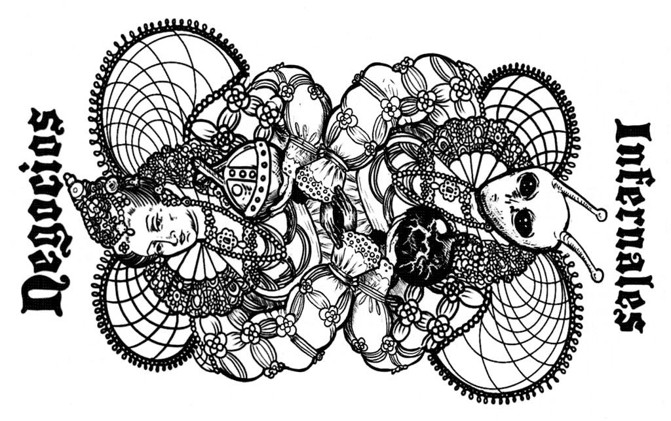 Other Weird and Beautiful Interviews #Weird Beauty Interviews on Black Gate:
Other Weird and Beautiful Interviews #Weird Beauty Interviews on Black Gate:
- Darrel Schweitzer THE BEAUTY IN HORROR AND SADNESS: AN INTERVIEW WITH DARRELL SCHWEITZER 2018
- Sebastian Jones THE BEAUTY IN LIFE AND DEATH: AN INTERVIEW WITH SEBASTIAN JONES 2018
- Charles Gramlich THE BEAUTIFUL AND THE REPELLENT: AN INTERVIEW WITH CHARLES A. GRAMLICH 2019
- Anna Smith Spark DISGUST AND DESIRE: AN INTERVIEW WITH ANNA SMITH SPARK 2019
- Carol Berg ACCESSIBLE DARK FANTASY: AN INTERVIEW WITH CAROL BERG 2019
- Byron Leavitt GOD, DARKNESS, & WONDER: AN INTERVIEW WITH BYRON LEAVITT 2021
- Philip Emery THE AESTHETICS OF SWORD & SORCERY: AN INTERVIEW WITH PHILIP EMERY 2021
- C. Dean Andersson DEAN ANDERSSON TRIBUTE INTERVIEW AND TOUR GUIDE OF HEL: BLOODSONG AND FREEDOM! (2021 repost of 2014)
- Jason Ray Carney SUBLIME, CRUEL BEAUTY: AN INTERVIEW WITH JASON RAY CARNEY(2021)
- Stephen Leigh IMMORTAL MUSE BY STEPHEN LEIGH: REVIEW, INTERVIEW, AND PRELUDE TO A SECRET CHAPTER(2021)
- John C. Hocking BEAUTIFUL PLAGUES: AN INTERVIEW WITH JOHN C. HOCKING (2022)
- Matt Stern BEAUTIFUL AND REPULSIVE BUTTERFLIES: AN INTERVIEW WITH M. STERN(2022)
- Joe Bonadonna MAKING WEIRD FICTION FUN: GRILLING DORGO THE DOWSER! 2022
- C.S. Friedman. BEAUTY AND NIGHTMARES ON ALIENS WORLDS: INTERVIEWING C. S. FRIEDMAN2023
- John R Fultz BEAUTIFUL DARK WORLDS: AN INTERVIEW WITH JOHN R. FULTZ(reboot of 2017 interview)
- John R Fultz, THE REVELATIONS OF ZANGBY JOHN R. FULTZ: READ THE FOREWORD AND INTERVIEW (2023)
- Robert Allen Lupton (2024) https://www.blackgate.com/2024/05/26/horror-and-beauty-in-edgar-rice-burroughs-work-an-interview-with-robert-allen-lupton/
- C.S.E. Cooney (2025) You are here!
- Interviews prior 2018 (i.e., with Janet E. Morris, Richard Lee Byers, Aliya Whitely …and many more) are on S.E. Lindberg’s website
S.E. Lindberg is a Managing Editor at Black Gate, regularly reviewing books and interviewing authors on the topic of “Beauty & Art in Weird-Fantasy Fiction.” He is also the lead moderator of the Goodreads Sword & Sorcery Group and an intern for Tales from the Magician’s Skull magazine. As for crafting stories, he has contributed eight entries across Perseid Press’s Heroes in Hell and Heroika series, and has an entry in Weirdbook Annual #3: Zombies. He independently publishes novels under the banner Dyscrasia Fiction; short stories of Dyscrasia Fiction have appeared in Whetstone, Swords & Sorcery online magazine, Rogues In the House Podcast’s A Book of Blades Vol I and Vol II, DMR’s Terra Incognita, and the 9th issue of Tales From the Magician’s Skull.
Comment on Worldbuilding Articles: Reader Poll (2025 Edition) by Carla Quinn
1. Sigl fashion (as a silversmith, I find this interesting and important)
2. Sigl recycling
3. Branch affinities
Stupid Rubbish

Update: Thank you so much for all of your support, guys. You are genuinely awesome and kind people. We are both lucky to know you. We finished the scene, it worked out well, so we are going to keep going and hopefully will stay on track for Friday.
There was a post here about something someone said, but it doesn’t seem important anymore. We are driving on.
Comments are locked because Mod R is working on something else and I do not have the time to devote to moderating at the moment.
The post Stupid Rubbish first appeared on ILONA ANDREWS.
Tuesday Musings: What Makes An Effective Villain?
I love villains. I love writing them. I love reading them. I love seeing them brought to life on big screen and small.
Well, let me modify that. I love villains in fiction and movies and television shows. I can’t stand real-life villains. (In the interest of keeping things civil, I won’t name any of the real-life villains I have in mind, even the one whose name rhymes with Peon Husk.) But a good fictional villain can make even the most mundane of stories shine. And a boring or ineffective villain can ruin an otherwise effective narrative. Over the years, as a reader, teacher, and editor, I have seen many beginning writers undermine their stories by making the same mistakes in the development of their antagonists.
 What qualities make a villain compelling? I intend to dive into that. Who are some of my favorite villains? I’ll get into that, too. But let me offer a few quick points up front. I don’t think much of the all-powerful-evil-through-and-through villains one often encounters in the fantasy genre. Sauron, for instance — the evil god whose world-conquering designs lie at the heart of J.R.R. Tolkien’s The Lord of the Rings — is, to my mind, a very boring villain. He’s really powerful, and he’s really, really evil. And yes, he’s cunning, which is a point in his favor, and he’s scary (or his minions are). But beyond that, and unless one has gone back and read all his backstory in The Silmarillion, there isn’t really much to him. He lacks dimension and complexity.
What qualities make a villain compelling? I intend to dive into that. Who are some of my favorite villains? I’ll get into that, too. But let me offer a few quick points up front. I don’t think much of the all-powerful-evil-through-and-through villains one often encounters in the fantasy genre. Sauron, for instance — the evil god whose world-conquering designs lie at the heart of J.R.R. Tolkien’s The Lord of the Rings — is, to my mind, a very boring villain. He’s really powerful, and he’s really, really evil. And yes, he’s cunning, which is a point in his favor, and he’s scary (or his minions are). But beyond that, and unless one has gone back and read all his backstory in The Silmarillion, there isn’t really much to him. He lacks dimension and complexity.
So, let’s begin there. In my opinion (and yes, ALL of this is just my opinion), villains should be complex. There should be more to them than mere evil. Their backstory should contain the seeds of their villainy and the twisting of their world-view. Because let’s face it, most of the villains we encounter and create do some pretty messed up things in pursuit of their agendas. They’re not all there sanity-wise. But how they wound up there ought to be an interesting tale in and of itself. And the fact that their actions are working at cross purposes with those of our protagonists should not mean they can’t have some normality and even joy in their lives. They can and should have people and things that they love. They should be relatable for our readers. One of my very favorite villains is Brandan of Ygrath, the emperor-sorcerer who is the villain of Guy Gavriel Kay’s Tigana. He is charming, brilliant, loving with those he cares about, handsome, refined. He is also ruthless, merciless, temperamental, and unpredictable. He does horrible, cruel, vicious things for reasons that are both understandable and insufficient. He is nearly as easy to like as he is easy to hate.
Too often, I see young authors make their villains unintelligent and unsubtle. They give their villains lots of power, but then undermine that power by making their machinations transparent. Villains, I believe, need to be canny, keen of mind, creative. Their schemes should be the stuff of genius. Remember the old Adam West Batman series? I used to watch it after school when I was little. Invariably, Batman’s foes would leave him in a situation where he wasn’t dead yet, but he would be soon. They were sure of it. So they didn’t need to wait around to make sure. They could leave, and eventually, the pendulum on the giant clock with the medieval axehead attached to it would cleave the masked crusader in two! And, of course, their premature departure gave Batman and the Boy Wonder the opportunity they needed to escape their less-than-certain deaths. Stupid villains were entertaining and convenient when we were kids watching bad TV. But for more sophisticated fiction, stupid villains will ruin a good tale.
Think of it this way: Assuming that our protagonist eventually manages to overcome the villain in our story, the power AND intelligence AND shrewdness of the bad guy reflect well on our good guy. The easier the villain is to defeat, the less challenging their plot against the world, the less impressive our hero appears when they prevail. When we build up our villain, when we make them really smart and really cunning, our hero’s victory becomes that much more of an achievement. Consider it narrative mathematics.
 Some of my favorite villains from my own work? Quinnel Orzili from the Islevale Cycle (Time’s Children, Time’s Demon, Time’s Assassin), Saorla from the second and third books in The Case Files of Justis Fearsson, and, my absolute favorite, Sephira Pryce from the Thieftaker books. Yes, she later become something other than a pure villain, but that was basically because she became SO much fun to write that I had to find a way to keep her around and relevant.
Some of my favorite villains from my own work? Quinnel Orzili from the Islevale Cycle (Time’s Children, Time’s Demon, Time’s Assassin), Saorla from the second and third books in The Case Files of Justis Fearsson, and, my absolute favorite, Sephira Pryce from the Thieftaker books. Yes, she later become something other than a pure villain, but that was basically because she became SO much fun to write that I had to find a way to keep her around and relevant.
 My favorite villains in the work of others? I already mentioned Brandan of Ygrath. John Rainbird, from Stephen King’s masterpiece, Firestarter, is a terrific villain. Smart, brutal, and yet also human. In Catie Murphy’s marvelous Negotiator trilogy there are two supernatural “bad guys,” Daisani and Janx, whose personal rivalry threatens the fabric of the mortal world. Their mutual animus and their own needs and desires humanize them and make them terrific foils for Magrit Knight, the series’ protagonist. And I would add that a certain writer I care not to mention in light of recent revelations has created some truly amazing villains. Too bad he wound up being a villain worthy of his own undeniable storytelling talents.
My favorite villains in the work of others? I already mentioned Brandan of Ygrath. John Rainbird, from Stephen King’s masterpiece, Firestarter, is a terrific villain. Smart, brutal, and yet also human. In Catie Murphy’s marvelous Negotiator trilogy there are two supernatural “bad guys,” Daisani and Janx, whose personal rivalry threatens the fabric of the mortal world. Their mutual animus and their own needs and desires humanize them and make them terrific foils for Magrit Knight, the series’ protagonist. And I would add that a certain writer I care not to mention in light of recent revelations has created some truly amazing villains. Too bad he wound up being a villain worthy of his own undeniable storytelling talents.
So, make your villains relatable, make them canny and dangerous and terrifying, and make their eventual defeat a true achievement for your protagonist. And try not to be villainous yourself.
Advice for this week. Cheers!!


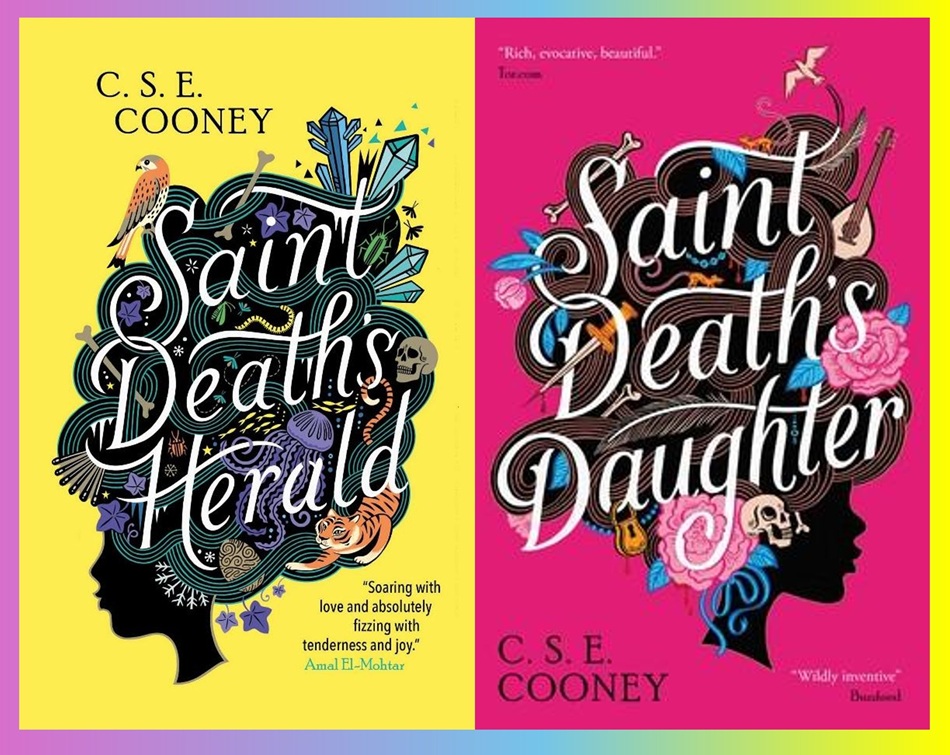
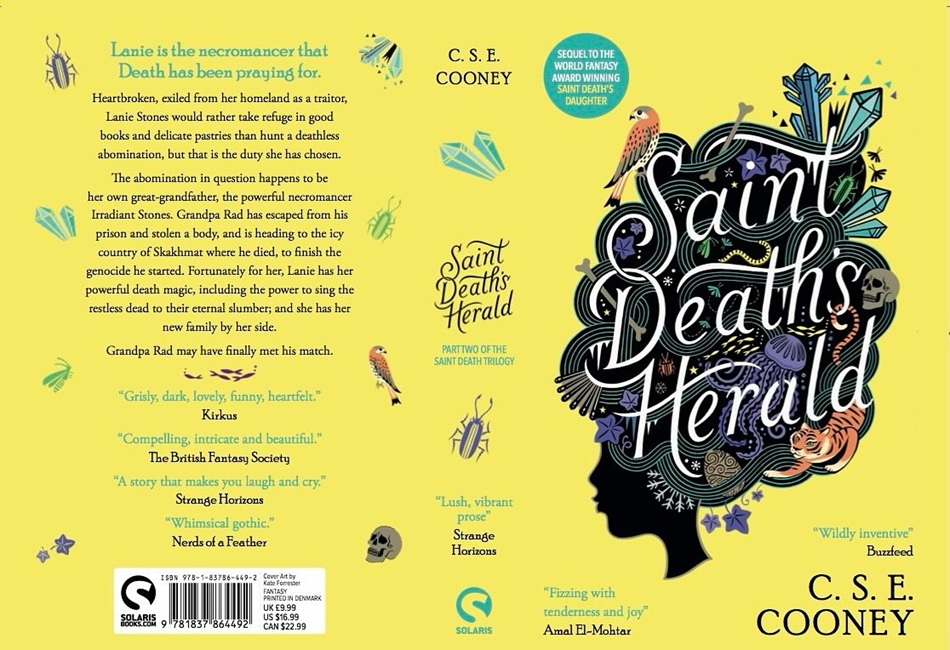
Recent comments